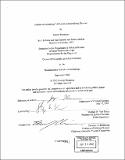| dc.contributor.advisor | Stephen W. Van Evera. | en_US |
| dc.contributor.author | Pressman, Jeremy, 1969- | en_US |
| dc.contributor.other | Massachusetts Institute of Technology. Dept. of Political Science. | en_US |
| dc.date.accessioned | 2005-10-14T19:32:43Z | |
| dc.date.available | 2005-10-14T19:32:43Z | |
| dc.date.copyright | 2002 | en_US |
| dc.date.issued | 2002 | en_US |
| dc.identifier.uri | http://hdl.handle.net/1721.1/29267 | |
| dc.description | Thesis (Ph. D.)--Massachusetts Institute of Technology, Dept. of Political Science, 2002. | en_US |
| dc.description | Includes bibliographical references (p. 275-287). Includes bibliographical references (p. 275-287). | en_US |
| dc.description.abstract | Does alliance restraint happen in international affairs? What theories explain the success or failure of restraint efforts? Do states ever form alliances in order to restrain? Alliance restraint - an actual or anticipated diplomatic effort by one ally to influence a second ally not to proceed with a proposed military policy or not to continue an existing military policy - most definitely happens in international affairs, and sometimes it is successful. This study of alliance restraint suggests three central conclusions about alliances: 1) On both a conceptual and empirical level, the alliance restraint dynamic means that alliances can have a stabilizing and peace-promoting effect on the international system. When calculating the net impact of alliances on international peace and stability, scholars should account for restraint, not just chainganging, buckpassing, and other pathological (destabilizing) alliance dynamics described by Waltz, Posen, Snyder & Christensen, and Vasquez. 2) The success or failure of restraint efforts is best explained by rational restraint theory - a combination of capabilities, interests, and communication. Rational restraint theory, analogous to rational deterrence theory, provides a better explanation than ones based on power, alliance norms, or domestic opinion. This is demonstrated in three cases of Anglo-American decisionmaking in the Middle East and Asia in the 1950s: Iran (1951), Indochina (1954), and Egypt (1956 Suez Crisis). | en_US |
| dc.description.abstract | (cont.) 3) Some states form alliances with the express purpose of restraining their new ally. This serves a reminder that the primary reason for a given alliance may be the policies and interactions of the allies themselves rather than those of an adversary. Such internal motivations as controlling, restraining, or re-making an ally are better explanations for the origin of some alliances than external motivations such as balancing against one's adversary based on considerations of power (Waltz) or threat (Walt). This has important policy implications for those making or analyzing alliances. | en_US |
| dc.description.statementofresponsibility | by Jeremy Pressman. | en_US |
| dc.format.extent | 287 p. | en_US |
| dc.format.extent | 13124225 bytes | |
| dc.format.extent | 13124024 bytes | |
| dc.format.mimetype | application/pdf | |
| dc.format.mimetype | application/pdf | |
| dc.language.iso | eng | en_US |
| dc.publisher | Massachusetts Institute of Technology | en_US |
| dc.rights | M.I.T. theses are protected by copyright. They may be viewed from this source for any purpose, but reproduction or distribution in any format is prohibited without written permission. See provided URL for inquiries about permission. | en_US |
| dc.rights.uri | http://dspace.mit.edu/handle/1721.1/7582 | |
| dc.subject | Political Science. | en_US |
| dc.title | Leashes or lemmings? : alliances as restraining devices | en_US |
| dc.type | Thesis | en_US |
| dc.description.degree | Ph.D. | en_US |
| dc.contributor.department | Massachusetts Institute of Technology. Department of Political Science | |
| dc.identifier.oclc | 51919116 | en_US |
